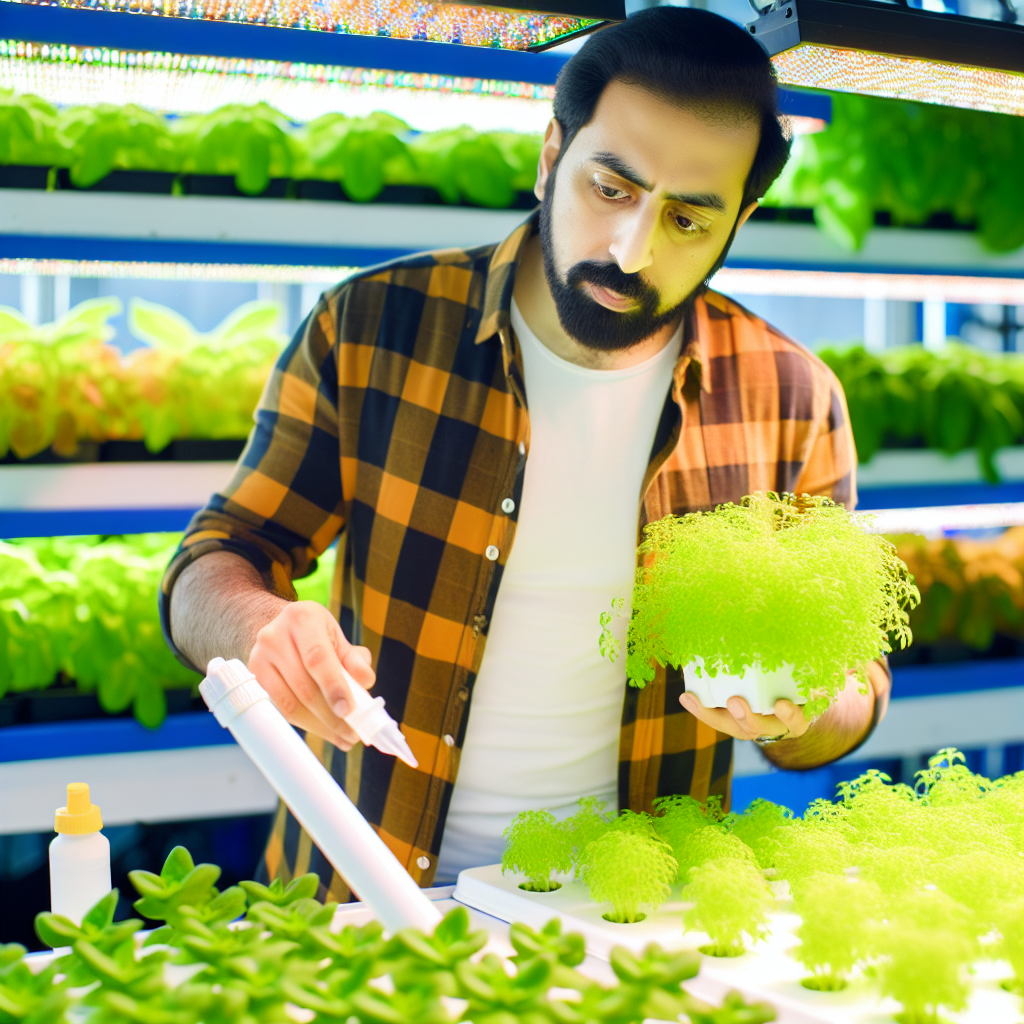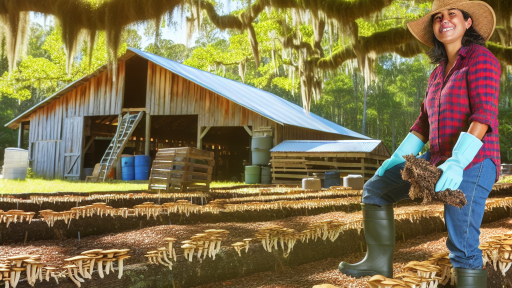Understanding the Basics of Hydroponics and Organic Farming
What is Hydroponics?
Hydroponics is a method of growing plants without soil.
Instead, it allows the roots to absorb nutrients from water solutions.
This technique uses various types of growing media like rockwool, clay pellets, or perlite.
Key Benefits of Hydroponics
Hydroponics offers several advantages for gardening enthusiasts.
- It optimizes space usage, allowing for high-density planting.
- Increased growth rates result from controlled nutrient and water delivery.
- Less water is needed compared to traditional farming methods.
Organic Farming Principles
Organic farming emphasizes the use of natural processes and materials.
This approach avoids synthetic fertilizers and pesticides.
Instead, it focuses on crop rotation, composting, and organic pest control.
Combining Hydroponics with Organic Practices
Integrating hydroponics with organic techniques is possible.
This combination promotes healthy plant growth without synthetic inputs.
Organic hydroponics uses natural fertilizers like fish emulsion or seaweed extract.
Essential Elements of Organic Hydroponics
To practice organic hydroponics, you need specific elements.
- Use organic-certified nutrients that adhere to strict guidelines.
- Incorporate beneficial microorganisms to enhance soil health.
- Employ biological pest control methods to manage pests naturally.
Challenges in Organic Hydroponics
While beneficial, organic hydroponics also presents challenges.
Managing nutrient levels can be complex without chemical fertilizers.
Additionally, pests and diseases require careful monitoring and control.
Creating an Organic Hydroponic Setup
Starting your organic hydroponic garden requires planning.
Transform Your Agribusiness
Unlock your farm's potential with expert advice tailored to your needs. Get actionable steps that drive real results.
Get StartedBegin by selecting the right hydroponic system for your space.
Next, choose organic seeds or seedlings that are disease-resistant.
A well-balanced nutrient solution is crucial for healthy plant growth.
Types of Hydroponic Systems Suitable for Organic Techniques
Nutrient Film Technique
The Nutrient Film Technique (NFT) supports organic gardening effectively.
This system utilizes a thin film of nutrient solution.
It continuously recirculates the solution to the plant roots.
This technique encourages rapid plant growth due to constant nutrient availability.
Moreover, NFT can be adapted for various organic nutrients.
Deep Water Culture
Deep Water Culture (DWC) proves to be another great option.
In this method, plants grow in a nutrient-rich water solution.
Air stones supply oxygen to the roots, ensuring optimal growth.
DWC systems are easy to manage and maintain.
You can easily incorporate organic fertilizers in this setup.
Ebb and Flow System
An Ebb and Flow system allows for flexible organic techniques.
This method floods the growing area with nutrient solution at intervals.
It drains back into a reservoir afterward.
This cycle provides roots with nutrients and oxygen effectively.
Additionally, it accommodates various organic growing mediums.
Wicking Systems
Wicking systems are simple yet effective for organic gardening.
These systems use a wick to draw nutrient solution to the plants from a reservoir.
It’s a passive technique that requires minimal maintenance.
This method works well for small-scale hydroponic gardens.
You can use organic solutions in conjunction with this system easily.
Aeroponics
Aeroponics is a highly efficient hydroponic method.
Showcase Your Farming Business
Publish your professional farming services profile on our blog for a one-time fee of $200 and reach a dedicated audience of farmers and agribusiness owners.
Publish Your ProfileIn this system, roots hang in the air and receive nutrient mist.
This technique optimizes oxygen delivery and nutrient uptake.
It also minimizes water usage significantly.
You can utilize organic nutrients effectively in aeroponics.
Vertical Hydroponic Systems
Implementing vertical systems can maximize space in small areas.
This method allows for multiple plant layers, improving yield.
You can create vertical setups using various hydroponic techniques.
These systems make it easier to manage organic nutrients.
Furthermore, they can enhance efficiency and accessibility for gardeners.
Essential Nutrients for Organic Hydroponic Gardens
Introduction to Nutrients
Nutrients play a critical role in hydroponic gardening.
They ensure healthy plant growth and development.
Understanding essential nutrients is crucial for success.
Macronutrients
Macronutrients form the foundation of plant nutrition.
Plants require these in larger quantities.
- Nitrogen promotes foliage growth.
- Phosphorus supports root and flower development.
- Potassium enhances overall plant health and disease resistance.
Maintaining the right balance of macronutrients is essential for thriving plants.
Micronutrients
Micronutrients are vital for various physiological functions.
Although required in smaller amounts, they are indispensable.
- Iron aids in chlorophyll production.
- Zinc helps in enzyme function and growth regulation.
- Manganese supports photosynthesis and nitrogen metabolism.
These micronutrients can significantly impact plant yield and quality.
Organic Sources of Nutrients
Organic hydroponic gardeners often seek natural nutrient sources.
Various organic options provide both macronutrients and micronutrients.
- Fish emulsion serves as a rich nitrogen source.
- Bone meal provides essential phosphorus.
- Seaweed extract offers a range of micronutrients.
Using these organic solutions can enhance soil microbiology.
Monitoring and Adjusting Nutrient Levels
Regular monitoring of nutrient levels is important.
This practice helps maintain optimal growing conditions.
Test solutions frequently to prevent deficiencies or excesses.
Adjust nutrient ratios based on plant growth stages.
Nutrient Management for Successful Gardening
Effective nutrient management leads to successful hydroponic gardens.
Integrating organic techniques enhances sustainability.
With consistent care and monitoring, gardeners can enjoy thriving plants.
Learn More: Composting Techniques For City Farms
Pest Management Strategies in Organic Hydroponics
Understanding the Importance of Pest Management
Pest management is crucial for successful hydroponic gardening.
Firstly, pests can damage plants and reduce yields significantly.
Moreover, organic techniques focus on preventing and controlling infestations.
Effective pest management maintains plant health and enhances productivity.
Identifying Common Pests
Identifying pests early is essential for effective control.
Common pests include aphids, whiteflies, and spider mites.
Regular monitoring helps spot these pests before they multiply.
Using sticky traps can assist in identifying pest presence quickly.
Implementing Preventative Measures
Preventative measures are the first line of defense against pests.
Start by maintaining a clean growing environment.
This practice minimizes the risk of infestations significantly.
Showcase Your Farming Business
Publish your professional farming services profile on our blog for a one-time fee of $200 and reach a dedicated audience of farmers and agribusiness owners.
Publish Your ProfileIncorporating beneficial insects can help control pest populations naturally.
For example, ladybugs are effective against aphids.
Organic Pest Control Methods
Organic control methods utilize natural solutions to address pest issues.
For instance, neem oil disrupts pest life cycles effectively.
Additionally, insecticidal soaps can eliminate soft-bodied insects.
Gardeners may also consider diatomaceous earth as a physical barrier.
Using Biological Control Agents
Biological control involves using organisms to manage pests naturally.
Introduce predatory insects or parasites to keep pest populations in check.
For example, parasitic wasps target aphids effectively.
Furthermore, beneficial nematodes can control soil-dwelling pests.
Monitoring and Adjusting Strategies
Regular monitoring is essential to evaluate pest management effectiveness.
Adjusting strategies based on pest populations ensures continued success.
Consider documenting pest sightings and control measures used.
This practice helps in tracking patterns and adjusting approaches accordingly.
Uncover the Details: Benefits of Heirloom Seeds for Sustainable Farming
Choosing Organic Seeds and Genetic Diversity in Hydroponics
The Importance of Organic Seeds
Organic seeds play a crucial role in hydroponic gardening.
They promote healthier plants free from synthetic chemicals.
Additionally, organic seeds encourage sustainable agricultural practices.
Choosing these seeds helps preserve biodiversity.
Benefits of Genetic Diversity
Genetic diversity enhances resilience in plants.
Diverse crops can better withstand pests and diseases.
This variation contributes to healthier ecosystems.
Moreover, it fosters adaptability to changing environmental conditions.
How to Select Organic Seeds
Begin by researching local seed suppliers.
Choose suppliers who prioritize organic practices.
Look for seeds that are certified organic.
It’s also beneficial to consider heirloom varieties.
Heirlooms often possess unique flavors and characteristics.
Incorporating Genetic Diversity in Your Garden
Plant a mix of varieties to encourage pollination.
Consider companion planting to increase biodiversity.
Rotate your crops to maintain soil health.
Regularly assess your plants for signs of disease.
This vigilance helps maintain genetic diversity over time.
Resources for Organic Seeds and Education
Many online resources provide information on organic seeds.
Join local gardening groups to share knowledge.
Attend workshops to learn about best practices.
Utilize extension services for guidance on organic gardening.
These resources can help you sustain a thriving hydroponic garden.
Learn More: Preserving Heritage Varieties on Your Farm

Soil-less Growing Media: Options for Organic Hydroponic Gardens
Overview of Soil-less Media
Soil-less growing media play a vital role in hydroponic gardening.
Showcase Your Farming Business
Publish your professional farming services profile on our blog for a one-time fee of $200 and reach a dedicated audience of farmers and agribusiness owners.
Publish Your ProfileThey provide plants with the necessary support and nutrients.
Moreover, these media facilitate optimal water retention and aeration.
Types of Organic Growing Media
Organic hydroponic gardens benefit from various growing media options.
These options include coconut coir, peat moss, and composted bark.
Coconut coir is a sustainable alternative to peat moss.
It retains moisture while offering excellent aeration properties.
Peat moss, though not entirely sustainable, provides effective water retention.
Composted bark adds essential nutrients and enhances drainage.
Coconut Coir
Coconut coir is made from the fibrous husk of coconuts.
This media is lightweight and environmentally friendly.
It improves drainage and retains moisture effectively.
Additionally, it can support beneficial microorganisms in the garden.
Peat Moss
Peat moss is harvested from decomposed sphagnum moss.
This media has excellent moisture retention capabilities.
It enriches the nutrient content of the hydroponic system.
However, its sustainable harvesting remains a concern.
Composted Bark
Composted bark is a mix of wood chips and decomposed organic matter.
This media provides good aeration and drainage for plant roots.
It also contains essential nutrients for plant growth.
Blending Soil-less Media
Blending different organic media can enhance performance.
A mix of coconut coir, peat moss, and composted bark improves moisture retention and aeration.
Consequently, plants thrive and demonstrate robust growth.
Choosing the Right Media
Selecting the best soil-less media depends on specific plant needs.
Consider factors like moisture retention and nutrient requirements.
Start by testing small batches to evaluate performance.
This method will help optimize the growing conditions for your hydroponic garden.
Find Out More: Setting Up Your First Aquaponic System
Balancing pH and EC Levels in Organic Hydroponic Solutions
Understanding pH and EC Levels
pH and EC levels are crucial in hydroponic gardening.
pH measures the acidity or alkalinity of your nutrient solution.
Conversely, EC indicates the concentration of dissolved salts.
Both parameters significantly influence plant health and growth.
Importance of Maintaining pH Levels
Maintaining the correct pH promotes nutrient absorption.
Most plants thrive in a pH range of 5.5 to 6.5.
Outside this range, nutrient availability decreases.
For instance, high pH can lock out iron and magnesium.
Additionally, low pH may result in nutrient toxicity.
Managing EC Levels
EC readings help determine the nutrient concentration.
A proper EC ensures your plants receive needed nutrients.
For most vegetative plants, aim for an EC of 1.5 to 2.5 mS/cm.
Monitor this regularly to avoid deficiencies or toxicities.
Showcase Your Farming Business
Publish your professional farming services profile on our blog for a one-time fee of $200 and reach a dedicated audience of farmers and agribusiness owners.
Publish Your ProfileMethods to Adjust pH Levels
Use pH adjusters to modify your nutrient solution.
Commonly, citric acid reduces pH levels effectively.
Alternatively, potassium hydroxide raises pH levels efficiently.
Always test the solution after adjustments.
Techniques to Adjust EC Levels
To lower EC levels, dilute your nutrient solution with water.
Conversely, add concentrations of nutrient solutions to increase EC.
Always monitor EC levels after making adjustments.
Regular Testing and Monitoring
Consistent testing is vital for healthy hydroponic gardens.
Invest in reliable pH and EC meters for accurate readings.
Perform tests daily, especially during critical growth phases.
Document your readings and adjustments for future reference.
Integrating Cover Crops and Companion Planting in Hydroponic Systems
Benefits of Cover Crops
Cover crops provide numerous benefits to hydroponic gardens.
They reduce nutrient leaching in the system.
Additionally, cover crops can improve moisture retention.
These crops also help in suppressing weeds.
Moreover, they contribute to soil health when composted.
Choosing the Right Cover Crops
Choosing suitable cover crops is vital for successful integration.
Leguminous plants such as clover enhance nitrogen levels.
Rye and oats work well for carbon addition and soil coverage.
Thus, consider local climate and specific gardening goals.
Companion Planting Fundamentals
Companion planting pairs compatible plants for mutual benefits.
This technique boosts growth and minimizes pests.
Strong-smelling plants can deter unwanted insects effectively.
Effective Companion Plants
Integrating specific companion plants can optimize garden health.
For example, basil benefits tomatoes by repelling pests.
Meanwhile, marigolds attract beneficial insects.
Additionally, certain herbs boost the flavor of neighboring crops.
Combining Techniques in Hydroponics
Using both cover crops and companion planting enhances diversity.
Diversity supports a balanced ecosystem within the hydroponic setup.
Furthermore, alternating crops can prevent disease buildup.
Implementation Steps
To integrate these techniques, start with planning.
Identify compatible plants for your specific hydroponic system.
Then, prepare the gardening area by ensuring adequate spacing.
Regular monitoring will help adjust the combination as needed.
Finally, document results to refine future planting strategies.
Additional Resources
An Interview With Eliot Coleman: The Original Organic Pioneer …




